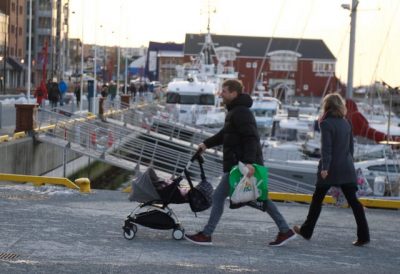Only 56,600 children were born in Norway last year, 2,300 fewer than in 2016 and resulting in the lowest national fertility rate ever recorded. With immigration growth also down, the declines are raising new worries about the consequences for the social welfare state.

The decline in the fertility rate, to 1.62 children per woman in Norway, was reported this week by state statistics bureau SSB (Statistics Norway). It comes despite Norway’s internationally recognized policies that provide generous maternity and paternity leave, financial support to all families regardless of income level, subsidized day care programs and other measures aimed at making it easier for parents to both work while raising children.
SSB reported that the national fertility rate has now fallen every year since 2009, and was down last year from 1.71 children per woman in 2016.
“It’s not usual to see such large changes in the SFT (Samlet fruktbarhetstall, the collective fertility rate nationwide) from one year to the next,” Espen Anderssen of SSB told news bureau NTB. “But the decline was also especially high in the 1970s.” He noted that Norway’s overall fertility rate fell, for example, from 2.13 in 1974 to 1.98 in 1975.
Births down in all age groups
Last year, though, the fertility rate sank in all age groups for the first time in many years. “The trend in recent years has been that fertility went down among women in their 20s and increased among women aged 30 and over,” Anderssen said. That reflected the trend that women have been postponing the birth of their first child until they’ve completed education, have a good job and a partner.
“Now it looks like the trend with steadily more births among women over 30 is beginning to turn around,” Anderssen said.
Women aged 30 to 34 continued to have the most babies, though, followed by women aged 25 to 29. Rogaland County in southwestern Norway logged the highest fertility rate, at 1.82 children per woman, while Oslo logged the lowest, at just 1.5 children per female resident. The Oslo number is still up, however, from an earlier low of 1.34 in 1983.
Fertility rates otherwise declined in all counties except Buskerud. The declines were largest in Telemark and Aust-Agder.
Immigration won’t offset decline
Among the 56,600 children born in Norway last year, 20 percent (11,200) were born to parents who are both immigrants in Norway. Immigration has recently fueled population growth in Norway, but with the immigration rate now also in decline, immigrants can no longer be relied upon to offset declines in the birth of babies expected to help pay for pensions and sustain the welfare state in years to come.
Sturla Løkken, a researcher at SSB, told Norwegian Broadcasting (NRK) that the fertility rate for 2017 was the lowest since statistics began being registered in the middle of the 1800s. At that time, long before the advent of birth control, it was not uncommon for women to give birth to many children, with some families having as many as 10 children or even more.
“We don’t know what the entire reason is (for the decline in the fertility rate), but it can be that women want to finish their studies and more are taking higher education,” Løkken told NRK. “It can also be important for them to break into the labour market, in order to qualify for the rights (like paid maternity leave) that follow with that.”
He warned that the decline in Norway’s fertility rate can have consequences: “There are fewer children. In the future there can perhaps be fewer who can pay taxes and fees so that we can get our pensions.” Calls were already going out for even better paid-leave and financial assistance packages for women in their 20s, to make it more attractive for them to have children while still studying.
Norway is by no means alone with its fertility rate decline. The numbers also are falling in most countries that are members of the OECD (Organisation for Economic Cooperation and Development). Fertility rates are also down in Sweden and Denmark, the two other Scandinavian countries known for well-established parental leave and day care programs for children.
newsinenglish.no/Nina Berglund

